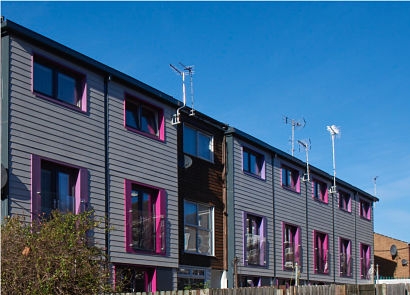
The report finds that a nationwide programme to upgrade the energy efficiency of existing homes is essential for the UK to achieve its carbon saving goals. It’s estimated that it costs the NHS £1.4 billion per annum in additional treatment costs for conditions arising from bad housing. Social housing, which accounts for 17 percent (4.5 million) of UK homes is ‘logical place to start’ and could lead the way in the greenhouse gas fight.
Energy used in homes accounts for about 20 percent of UK greenhouse gas emissions and three quarters of that comes from heating and hot water. 80 percent of the homes people will inhabit in 2050 have already been built, meaning it is not possible to rely on new builds alone to meet legal energy-saving targets set in the 2008 Climate Change Act.
Deep retrofitting is a whole-house approach to upgrading the energy efficiency in one step as opposed to a series of incremental improvements over a long period of time. This includes: Adding solar panels and local micro generation, insulation and ventilation, and sustainable heating systems.
“If we are to meet the 2050 targets of the Climate Change Act, then all housing in the UK must have zero carbon emissions from space and water heating, and space cooling” said Rick Hartwig, IET Built Environment Lead. “New and innovative products will always assist in reducing costs and improving energy performance, but sufficient work has already been done in research and pilot studies, to show that massively reducing the carbon emissions and energy requirements of current housing is achievable and needs to be done. Retrofitting has other benefits too, making cold homes warmer, healthier and reducing bills”.
Mr Hartwig added that there is considerable practical experience in financing deep retrofit projects, managing them, and engaging with the householders and that the UK needs to build on that experience to create a national retrofit programme to deliver the country’s 2050 goals. This will not only help drive demand but allow greater scale to cut the costs per property.
A one-off deep retrofit versus 30 years of ongoing maintenance costs gives better economic outcomes and a quicker improvement in housing quality. This is not just a technological challenge; Governments - both national and local - must take the lead in encouraging and supporting the necessary changes which will in turn support clean growth.
“Achieving retrofits to 2050 standards is technically challenging and currently too expensive” said Professor Marjan Sarshar, Nottingham Trent University. “New knowledge based supply chains, advanced manufacturing techniques and better business models are necessary to reduce costs. Ten early demonstrators have already been achieved in Nottingham, through an EU project called Remourban. Joint action from government and Registered Social Landlords (RSLs) will allow scaling up of these early experiences at a national level.”
Current barriers to the development of a national programme include: lack of customer demand – the proposition is still not attractive enough; no effective policy driver for change; costs per home are too high as there is not yet a supply chain that can deliver deep retrofits cost effectively, in volume and at speed; and a lack of initial financing.
The report calls for both national and local Government to take the lead in encouraging and supporting the necessary changes, which include:
Create clear, consistent policy objectives and a national programme for deep retrofit and climate resilience, with an initial focus on social housing.
Reduce costs and build the supply chain capacity by developing more pilot projects and demonstrators. This will bring the cost-per-property to below 30-year repair, maintenance and refurbishment budgets. This is a big economic opportunity for the supply chain.
Engage with the home owners by identifying the best ways to discuss the benefits of deep retrofit and developing trusted intermediaries to be a single point of contact for owners and tenants.
Encourage investment by creating larger projects that are more attractive to investors, by aggregating smaller retrofit projects into bigger blocks and introducing more flexible ways for local authorities to borrow and invest in retrofit programmes.
Image: Courtesy of Energiesprong International
For additional information:
‘Scaling Up Retrofit 2050’ report

